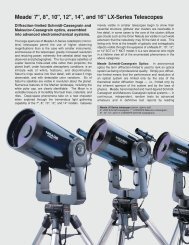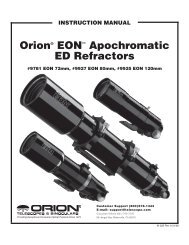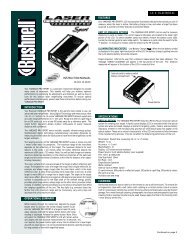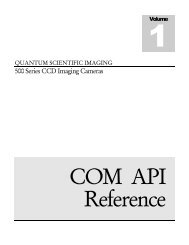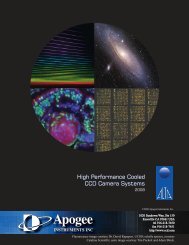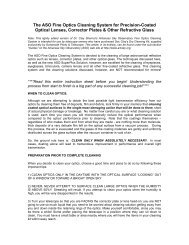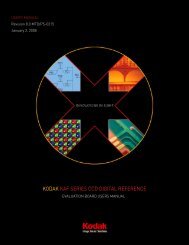Orion AstroView 90 EQ Instructions - Oceanside Photo and Telescope
Orion AstroView 90 EQ Instructions - Oceanside Photo and Telescope
Orion AstroView 90 EQ Instructions - Oceanside Photo and Telescope
Create successful ePaper yourself
Turn your PDF publications into a flip-book with our unique Google optimized e-Paper software.
are good, you may be able to resolve thin cloud b<strong>and</strong>s on the<br />
planet’s disk.<br />
SATURN The ringed planet is a breathtaking sight when it is<br />
well positioned. The tilt angle of the rings varies over a period<br />
of many years; sometimes they are seen edge-on, while at<br />
other times they are broadside <strong>and</strong> look like giant “ears” on<br />
each side of Saturn’s disk. A steady atmosphere (good seeing)<br />
is necessary for a good view. You may probably see a<br />
tiny, bright “star” close by; that’s Saturn’s brightest moon,<br />
Titan.<br />
VENUS At its brightest, Venus is the most luminous object in<br />
the sky, excluding the Sun <strong>and</strong> the Moon. It is so bright that<br />
sometimes it is visible to the naked eye during full daylight!<br />
Ironically, Venus appears as a thin crescent, not a full disk,<br />
when at its peak brightness. Because it is so close to the<br />
Sun, it never w<strong>and</strong>ers too far from the morning or evening<br />
horizon. No surface markings can be seen on Venus, which<br />
is always shrouded in dense clouds.<br />
MARS If atmospheric conditions are good, you may be able<br />
to see some subtle surface detail on the Red Planet, possibly<br />
even the polar ice cap. Mars makes a close approach<br />
to Earth every two years; during those approaches its disk is<br />
larger <strong>and</strong> thus more favorable for viewing.<br />
D. Stars<br />
Stars will appear like twinkling points of light in the telescope.<br />
Even powerful telescopes cannot magnify stars to appear<br />
as more than points of light! You can, however, enjoy the different<br />
colors of the stars <strong>and</strong> locate many pretty double <strong>and</strong><br />
multiple stars. The famous “Double-Double” in the constellation<br />
Lyra <strong>and</strong> the gorgeous two-color double star Albireo in<br />
Cygnus are favorites. Defocusing the image of a star slightly<br />
can help bring out its color.<br />
E. Deep-Sky Objects<br />
Under dark skies, you can observe a wealth of fascinating<br />
deep-sky objects, including gaseous nebulas, open <strong>and</strong><br />
globular star clusters, <strong>and</strong> different types of galaxies. Most<br />
deep-sky objects are very faint, so it is important that you<br />
find an observing site well away from light pollution. Take<br />
plenty of time to let your eyes adjust to the darkness. Don’t<br />
expect these subjects to appear like the photographs you<br />
see in books <strong>and</strong> magazines; most will look like dim gray<br />
smudges. (Our eyes are not sensitive enough to see color<br />
in such faint objects.) But as you become more experienced<br />
<strong>and</strong> your observing skills get sharper, you will be able to discern<br />
more subtle details.<br />
Remember that the higher the magnification you use, the<br />
dimmer the image will appear. So stick with low power when<br />
observing deep-sky objects, because they’re already very<br />
faint.<br />
How to Find Interesting Celestial Objects—<br />
Starhopping<br />
Star hopping, as it is called by astronomers, is perhaps the<br />
simplest way to hunt down deep-sky objects to view in the<br />
night sky. It entails first pointing the telescope at a bright star<br />
close to the object you wish to observe, <strong>and</strong> then progressing<br />
Figure 7. Starhopping is a good way to locate hard-to-find<br />
objects. Refer to a star chart to map a route to the object that uses<br />
bright stars as guideposts. Center the first star you’ve chosen<br />
in the finder scope <strong>and</strong> telescope eyepiece (1). Now move the<br />
scope carefully in the direction of the next bright star (2), until it<br />
is centered. Repeat (3 <strong>and</strong> 4). The last hop (5) should place the<br />
desired object in the eyepiece.<br />
to other stars closer <strong>and</strong> closer to the object until it is in the<br />
field of view of the eyepiece. It is a very intuitive technique<br />
that has been employed for hundreds of years by professional<br />
<strong>and</strong> amateur astronomers alike. Keep in mind, as with any<br />
new task, that star hopping may seem challenging at first, but<br />
will become easier over time <strong>and</strong> with practice.<br />
To star hop, only a minimal amount of additional equipment<br />
is necessary. A star chart or atlas that shows stars to at least<br />
magnitude 5 is required. Select one that shows the positions<br />
of many deep-sky objects, so you will have a lot of options to<br />
choose from. If you do not know the positions of the constellations<br />
in the night sky, you will need a planisphere to identify<br />
them.<br />
Start by choosing bright objects to view. The brightness of<br />
an object is measured by its visual magnitude; the brighter<br />
an object, the lower its magnitude. Choose an object with<br />
a visual magnitude of 9 or lower. Many beginners start with<br />
the Messier objects, which represent some of the best <strong>and</strong><br />
brightest deep-sky objects, first catalogued about 200 years<br />
ago by the French astronomer Charles Messier.<br />
Determine in which constellation the object lies. Now, find the<br />
constellation in the sky. If you do not recognize the constellations<br />
on sight, consult a planisphere. The planisphere gives<br />
an all-sky view <strong>and</strong> shows which constellations are visible on<br />
a given night at a given time.<br />
Now, look at your star chart <strong>and</strong> find the brightest star in the<br />
constellation that is near the object you are trying to find.<br />
12





